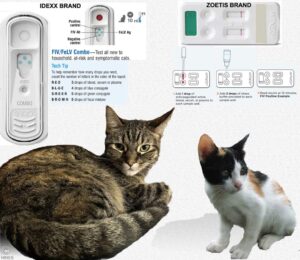Understanding Your Cat’s Feline Leukemia And Feline FIV/”AIDS” Tests
Ron Hines DVM PhD
 FIV / Feline Immunodeficiency Virus
FIV / Feline Immunodeficiency Virus
We are fortunate that feline leukemia (FeLV) is not as common as it once was. That is thought to be due to the very effective vaccines your veterinarian now has to vaccinate your young cat. (read here) Unfortunately, little has changed regarding the prevalence of the feline immunodeficiency virus (FIV). That is because no effective vaccines exist to prevent it. There once was one, Fel-O-Vax® FIV (from 2002 to 2017). It was not very effective. (read here) And because it was adjuvanted, the vaccination ran the risk of producing fibrosarcoma cancer. You can read about both those diseases through the links at the top of this page. For a closer look at the test itself, expand the first cat and kitten’s image as well.
Both FeLV and FIV are retrovirus that target your cat’s immune system – specifically your cat’s CD4+ T cells. The two viruses differ clinically in the speed with which they affect your cat’s health, and in the likelihood that your cat will succeed in eliminating them on its own. Feline leukemia is by far the most serious of the two. The symptoms of both these viruses can be quite similar. So, the only way your veterinarian can know which of them your cat is dealing with is by detecting the protein signature of the FeLV virus itself, or by confirming the presence of antibodies your cat produces against FIV. Veterinary clinics throughout the world now have in-office (“point-of-care”) tests that rapidly do that. The most common in-office tests used in North America today are manufactured by Idexx Laboratories of Westbrook, Maine and Zoetis Inc. of Parsippany, New Jersey. Both competing products are patented variations of the immunochromatography and ELISA test procedures.
How Common Are These Two Cat Viruses?
Various studies report between 3 and 10% of cats in North America as being infected with one of these two viruses. But the percentage changes drastically depending on what population of cats is being sampled. Besides that, estimates are that only ~40% of cats in the United States ever visit a veterinary hospital for post-neuter care, if that. The majority of homeless and feral cats never get tested for anything. (read here) So these estimates are probably falsely low among the general cat population, high among feral cat colonies where transmission risks are greatest, and highest among cats presented to veterinarians because of declining general health issues.
How Reliable Are These Two Tests? Is One Company’s Test More Accurate Than Another?
I do not know of any blinded studies that examined that. As one might expect, the studies paid for by Idexx find that their SNAP FIV/FeLV Combo Test is better than Zoetis’ WITNESS® FeLV-FIV Test. (read here) While the studies paid for by Zoetis find that their WITNESS® FeLV-FIV Test was undeniably better than Idexx’s SNAP FIV/FeLV Combo or Abaxis’ VetScan™. (read here) While the studies paid for by Idexx find the opposite. (read here) Would you trust Ford to be unbiased in rating a Chevrolet, or vice versa?
However, we do know that neither of these tests are 100% accurate. They are all good products. But much depends on how long the virus has been present in your cat and the expertise of the individual performing the test in interpreting cliffhanger results. Early in infections with either virus, there may not be enough virus present to trigger positive results. These tests depend on color changes. Very slight changes can be an illusion, or in the eye of the beholder. So, any FeLV/FIV test results that are not obvious one way or the other need to be repeated at a later date or confirmed by an IFA or PCR test performed at a large veterinary diagnostic laboratory. Even central lab-run IFA tests have been known to yield false negatives in FIV+ and FeLV+ cats early in the disease when the virus has not yet established itself in sufficient numbers in the cat’s bone marrow. (ask me for Westman2019.pdf) Theoretically, PCR tests should never return false positives, but even PCR tests have their limitations. (read here) Statistically, false, weakly positive, in-office tests are more common than false-negative tests because so many more cats in the general population are free of both viruses. Unlike the situation with FIV-vaccinated cats, cats vaccinated against FeLV are not believed to give positive FeLV test results. However, the feline leukemia virus also exists in a defective provirus form in some currently-healthy cats. Although those provirus may not be currently capable of causing disease (and might never be), they have been known to trigger positive test results in the in-office FeLV tests that veterinarians commonly use. So if your cat tests positive at the animal hospital, it is wise to request that a blood sample be sent to a central veterinary laboratory for a confirmatory PCR/ IFA test to confirm that your cat actually harbors FeLV viruses that are capable of causing disease (=virulent virus). (read here)
 When Should These In-Office Tests Be Performed?
When Should These In-Office Tests Be Performed?
 When your young or teenage cat is showing signs of illness that your veterinarian cannot attribute to a specific disease, particularly repeat infections, weight loss and fever.
When your young or teenage cat is showing signs of illness that your veterinarian cannot attribute to a specific disease, particularly repeat infections, weight loss and fever.
 When your cat that has not been recently tested, relapses, despite what should have been effective treatment.
When your cat that has not been recently tested, relapses, despite what should have been effective treatment.
 Whenever a new cat is being considered for a family member. But read #4 because both FIV and FeLV have substantial incubation periods during which these tests cannot recognize infection yet.
Whenever a new cat is being considered for a family member. But read #4 because both FIV and FeLV have substantial incubation periods during which these tests cannot recognize infection yet.
 Thirty to sixty days after your cat was lost, and a substantial time passed before it was found and returned to you, or 30–60 days after any potential FIV/FeLV exposure. The test results are usually accurate for FeLV 30 days after exposure. However, cats that have been infected with FIV often take longer before their tests come back positive. Cornell University mentions that it can take up to 6 months for a few cats infected with FIV to develop enough antibodies to trigger a positive test. Kittens born to FIV+ mothers often test false+ to FIV due to residual maternal antibodies in their system for up to ~6 months. Veterinarians screening large numbers of shelter cats suggest the these tests accurately detect FeLV infected cats 30 days after exposure and FIV infected cats 60 days after exposure. Your options are to have the tests run at 30 and 60 days or a single test on ~day 45. You and your veterinarian need to discuss that, since so many factors come into play.
Thirty to sixty days after your cat was lost, and a substantial time passed before it was found and returned to you, or 30–60 days after any potential FIV/FeLV exposure. The test results are usually accurate for FeLV 30 days after exposure. However, cats that have been infected with FIV often take longer before their tests come back positive. Cornell University mentions that it can take up to 6 months for a few cats infected with FIV to develop enough antibodies to trigger a positive test. Kittens born to FIV+ mothers often test false+ to FIV due to residual maternal antibodies in their system for up to ~6 months. Veterinarians screening large numbers of shelter cats suggest the these tests accurately detect FeLV infected cats 30 days after exposure and FIV infected cats 60 days after exposure. Your options are to have the tests run at 30 and 60 days or a single test on ~day 45. You and your veterinarian need to discuss that, since so many factors come into play.
Since FIV is transmitted primarily through cat bites, most kittens that are born to FIV+ mothers will test positive for FIV initially, but they will gradually test negative over the coming 6 months because they were never bitten and there never were FIV virus in their bodies.
 When another FIV+/FeLV cat has been identified in your household.
When another FIV+/FeLV cat has been identified in your household.
 Prior to release for adoption from an animal shelter or cat rescue. Insist on it. You agree to cover the test’s cost and be sure that an experienced veterinary nurse performs the test. Again, as mentioned in #4, negative test results at the time of adoption is not an iron clad guarantee.
Prior to release for adoption from an animal shelter or cat rescue. Insist on it. You agree to cover the test’s cost and be sure that an experienced veterinary nurse performs the test. Again, as mentioned in #4, negative test results at the time of adoption is not an iron clad guarantee.
 All kittens born to a FIV or FeLV-positive queen. Before adoption or placement, and again at 4 months of age. Four months of age will catch most infected cats, but not every last one of them. A test at 6 months of age usually does. That is because FeLV virus /or FIV antibodies must reach substantial levels to trigger positive test results. Tests performed at a central lab might be a better choice than in-office test kits, but few rescues can afford that. Kittens can also test false-positive due to antibodies passed on to them through their mother’s first milk (colostrum). Many of those false-positive kittens return negative test results sixty days later. Some shelters only test the mother (when she is available) and then test the infants should she turn out to be positive. Others operating on a shoestring might just test one kitten out of a litter. Still others might pool the blood sample from the entire litter of kittens and use that in one of the two in-office tests (really not a good idea). Administering feline leukemia-containing vaccines to kittens at recommended times are not thought to influence in-office test results (read here)
All kittens born to a FIV or FeLV-positive queen. Before adoption or placement, and again at 4 months of age. Four months of age will catch most infected cats, but not every last one of them. A test at 6 months of age usually does. That is because FeLV virus /or FIV antibodies must reach substantial levels to trigger positive test results. Tests performed at a central lab might be a better choice than in-office test kits, but few rescues can afford that. Kittens can also test false-positive due to antibodies passed on to them through their mother’s first milk (colostrum). Many of those false-positive kittens return negative test results sixty days later. Some shelters only test the mother (when she is available) and then test the infants should she turn out to be positive. Others operating on a shoestring might just test one kitten out of a litter. Still others might pool the blood sample from the entire litter of kittens and use that in one of the two in-office tests (really not a good idea). Administering feline leukemia-containing vaccines to kittens at recommended times are not thought to influence in-office test results (read here)
As I mentioned, when doubts persist, immunofluorescent antibody (IFA) tests and PCR tests performed at a central lab are the most accurate way to determine your kitten or cat’s true FIV/FeLV status. At some point the ELISA, IFA and/or PCR tests should all agree.
As I also mentioned, a few FeLV+ young cats will return negative results on subsequent tests for the virus. Current thinking is that these cats represent abortive infections in which the cat’s immune system managed to destroy all of the pathogenic FeLV virus in its body. Read more about Abortive FeLV infection here.
You are on the Vetspace animal health website
Visiting the products that you see displayed on this website help pay the cost of keeping these articles on the Internet.


